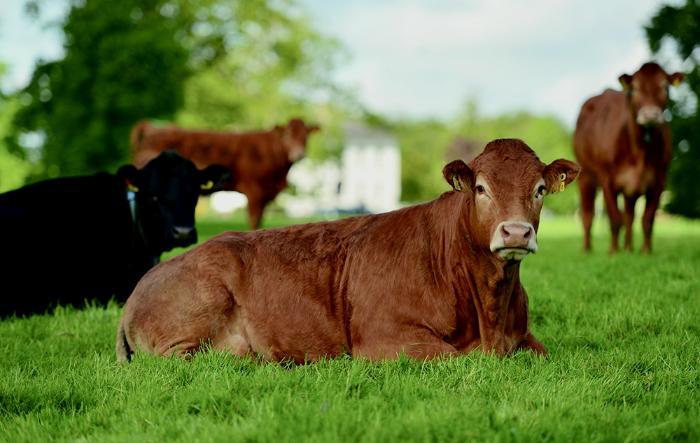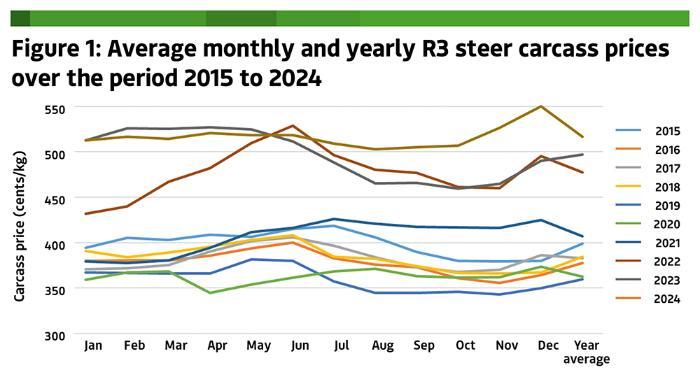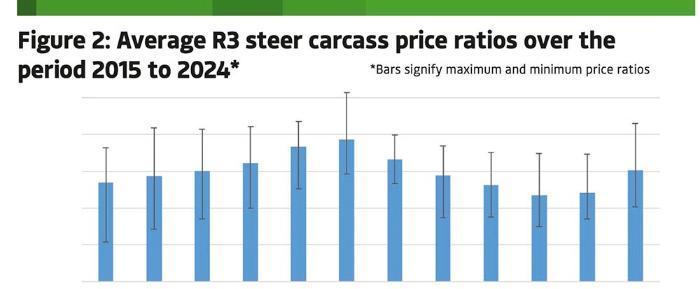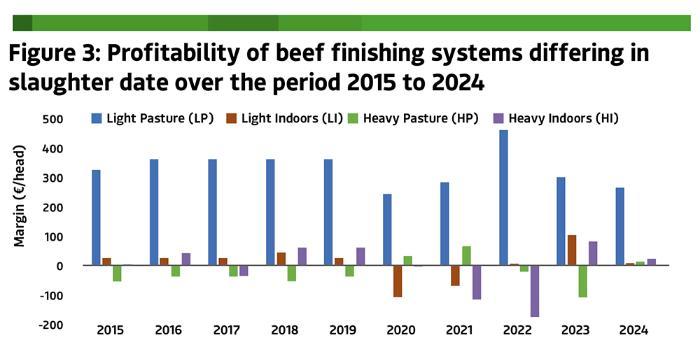20 February 2025
Modelling seasonality of beef finishing systems
Researchers at Teagasc Grange are exploring how seasonality impacts beef prices and farm profitability, using bioeconomic models to examine Irish beef production systems and the potential of altering slaughter dates.

Beef production systems maximising the use of grazed grass have potential for greater profitability. Credit: Teagasc
Seasonality affects beef prices, with significant implications for farm profitability. Teagasc researchers used bioeconomic models to study how seasonality impacts Irish beef production systems.
Irish grass-fed beef is produced in systems involving spring-born calves fed diets of 80–90% grass and conserved forage. Grazing for up to ten months a year provides high animal welfare credentials, valued by consumers nationally and internationally. Grass-based systems offer a competitive advantage by minimising purchased feed. Additionally, they enhance sustainability through carbon sequestration, biodiversity and minimal competition with human-edible food production.
Farm level profitability: a key challenge
Despite these advantages, profitability at the farm level continues to be low. Average beef farm incomes in 2023 stood at €7,425 (cattle rearing) and €14,735 (other cattle) with farm incomes in some cases supplemented with off-farm income. A key lever to improve farm profitability is maximising beef prices for animal sales. “We know that beef prices typically follow the law of supply and demand, with peak factory slaughtering in autumn coinciding with the lowest carcass prices when beef farmers sell their stock as grass supply tightens” explains Denis Meehan, a Meat Technology Ireland (MTI)-funded postdoctoral researcher at Teagasc Grange.
“This trend is reversed in the spring when cattle supplies fall and prices respond accordingly, illustrating the effect of seasonality on beef price trends,” he adds. Thus, there are opportunities to affect beef prices by altering the sale date; consequences for feed costs and carcass traits must be considered. Results from a study on these factors were presented at the British Society of Animal Science (BSAS) conference in Belfast in 2024.
The basics of beef systems modelling
The approach followed was to use historic Bord Bia-published weekly beef prices from 2015 to 2024 to tabulate monthly beef price ratios (i.e. monthly price as a proportion of average yearly price) for all carcass conformation and fat scores. Applying these data to bioeconomic systems models developed at Teagasc Grange, four beef finishing systems were simulated, differing in slaughter age and month and weight at purchase. Price ratios relating to the respective slaughter months were applied within these models to determine the respective beef systems’ profitability levels (as average margin, €/head/year).
Bioeconomic models are a widely used approach applied in animal production systems research, explains Denis.
“Such models quantify all physical inputs and farm-level interactions occurring in beef cattle production from birth to finish. ‘Partial’ systems e.g. yearling to finish, as operated on many farms, can be extracted from these systems as required. Key outputs are produced relating to the financial, physical and environmental characteristics of the system modelled.”
The four beef systems analysed in this present study involved March-born late maturing crossbred steers purchased in September as either ‘heavy’ (580kg) or ‘light’ (480kg) animals. Heavy animals were finished at pasture (P) at 20 months (HP, October slaughter) or indoors (I) at 22 months (HI, January slaughter) with the light animals finished indoors at 25 months (LI, April slaughter) or pasture at 28 months (LP, June slaughter).

Figure 1: Average monthly and yearly R3 steer carcass prices over the period 2015 to 2024
The effects of seasonality
Pronounced intra- and inter-year fluctuations in beef prices were observed over the period 2015-2024 with the historically high beef prices in 2024 (R3-graded steers presented in Figure 1) yielding a year average price 43% greater than the corresponding price for 2019 (516 vs. 359 c/kg carcass), the lowest year average price over the ten-year study period.
Average monthly price ratios over the ten years showed a general increasing trend from the beginning of the year until June. Beyond this, they reverted towards the year-end (R3 carcass data presented in Figure 2) before registering a further increase in December on the back of rising Christmas demand. A similar trend was seen for all other carcass categories.
Large differences in margins (€/head) were seen in the profitability of the systems between years with the highest margins ranging from €247 to €467/head seen with LP (Figure 3).
“This arises because this system had the greatest numbers of days at grass (at 165 days), greatest grass and forage proportion in the diet (94%) and greatest carcass weight (395kg), while also having the least concentrate input (200kg), while its June slaughter date coincided with peak carcass prices and price ratios,” notes Denis.
Interestingly, the second most profitable system, the LI, had the highest concentrate input (one tonne) despite producing a lower carcass weight of 385kg. “This illustrates the extent to which seasonality can offset the added costs associated with higher concentrate system inputs.”

Figure 2: Average R3 steer carcass price ratios over the period 2015 to 2024
Re-ranking profitability
The yearly impact of price seasonality over the ten-year period also led to some re-ranking in the profitability of the remaining three systems. These data relate to profit per head; a key issue to consider in this regard is that the longer on-farm period for the LP system (ten months) compared to the other systems reduces the number of animals that can be accommodated on farm. This has implications for profitability per hectare. In this present analysis, despite reducing the advantage of LP, the ranking was unchanged on a per-hectare basis.
“One can never predict the future, but systems modelling can help beef farmers make more informed decisions when there are a large number of farm system variables and output metrics to consider,” concludes Paul Crosson, Grange’s Beef Enterprise Leader and Lead Researcher on this project. Future research is aimed at examining the relationship between environmental sustainability (as carbon footprint) and economic sustainability of beef finishing systems.

Figure 3: Profitability of beef finishing systems differing in slaughter date over the period 2015 to 2024
Take home message
Beef production systems that maximise the use of grazed grass are more profitable than those requiring more prolonged indoor feeding periods, and based on the current seasonality of cattle supplies, prices are highest in summer. Therefore, production systems which finish cattle at this time of year are most profitable.
Funding
This research was funded through the support of Meat Technology Ireland Phase 2 (Ref PN 1647 & DAFM/28/2016/PR.EFP).
Contributors
Denis Meehan, MTI Postdoctoral Researcher, Teagasc Grange. denis.meehan@teagasc.ie
Edward O’Riordan, Beef Systems Researcher, Teagasc Grange.
Paul Crosson, Lead Researcher and Beef Enterprise Leader, Teagasc Grange.
